Neil Houlsby
Compression Scaling Laws:Unifying Sparsity and Quantization
Feb 23, 2025Abstract:We investigate how different compression techniques -- such as weight and activation quantization, and weight sparsity -- affect the scaling behavior of large language models (LLMs) during pretraining. Building on previous work showing that weight sparsity acts as a constant multiplier on model size in scaling laws, we demonstrate that this "effective parameter" scaling pattern extends to quantization as well. Specifically, we establish that weight-only quantization achieves strong parameter efficiency multipliers, while full quantization of both weights and activations shows diminishing returns at lower bitwidths. Our results suggest that different compression techniques can be unified under a common scaling law framework, enabling principled comparison and combination of these methods.
PaliGemma: A versatile 3B VLM for transfer
Jul 10, 2024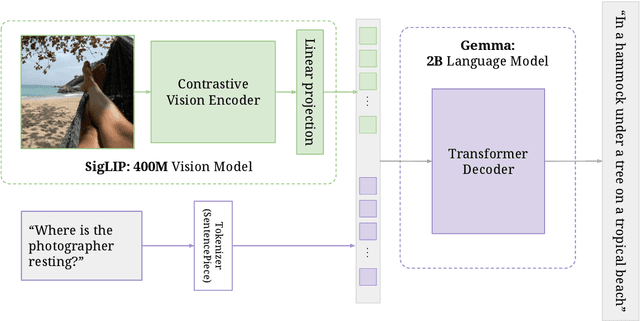
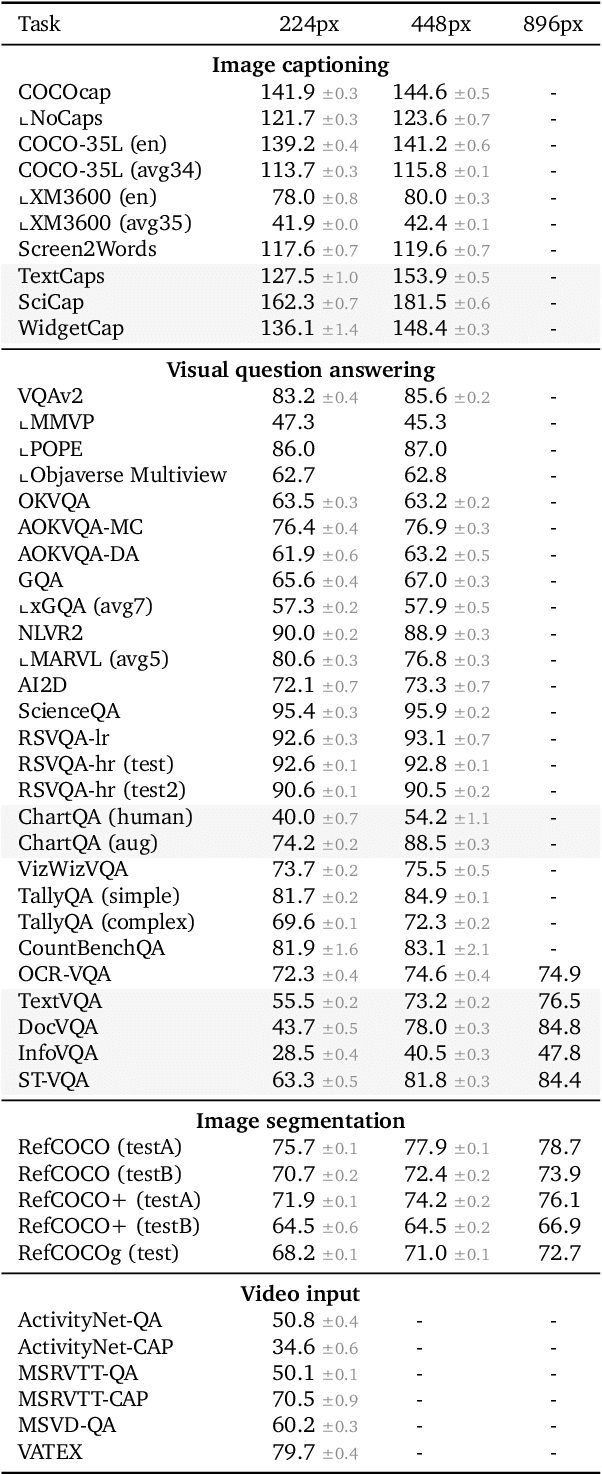
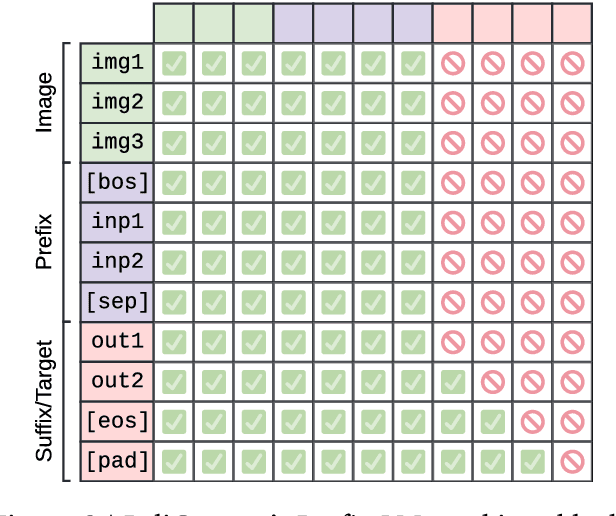
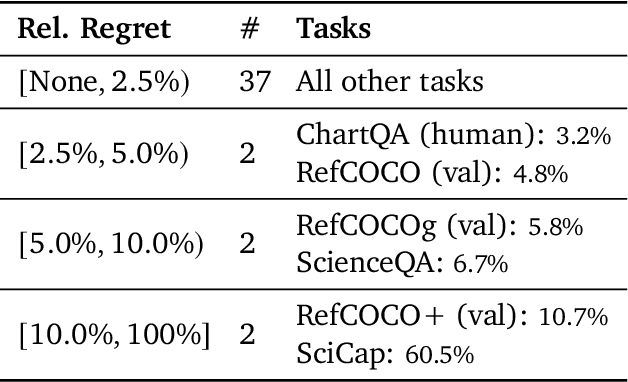
Abstract:PaliGemma is an open Vision-Language Model (VLM) that is based on the SigLIP-So400m vision encoder and the Gemma-2B language model. It is trained to be a versatile and broadly knowledgeable base model that is effective to transfer. It achieves strong performance on a wide variety of open-world tasks. We evaluate PaliGemma on almost 40 diverse tasks including standard VLM benchmarks, but also more specialized tasks such as remote-sensing and segmentation.
Semantica: An Adaptable Image-Conditioned Diffusion Model
May 23, 2024Abstract:We investigate the task of adapting image generative models to different datasets without finetuneing. To this end, we introduce Semantica, an image-conditioned diffusion model capable of generating images based on the semantics of a conditioning image. Semantica is trained exclusively on web-scale image pairs, that is it receives a random image from a webpage as conditional input and models another random image from the same webpage. Our experiments highlight the expressivity of pretrained image encoders and necessity of semantic-based data filtering in achieving high-quality image generation. Once trained, it can adaptively generate new images from a dataset by simply using images from that dataset as input. We study the transfer properties of Semantica on ImageNet, LSUN Churches, LSUN Bedroom and SUN397.
SciFIBench: Benchmarking Large Multimodal Models for Scientific Figure Interpretation
May 14, 2024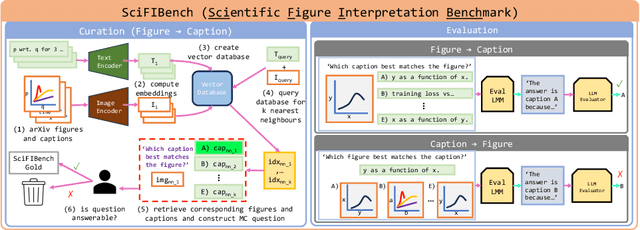

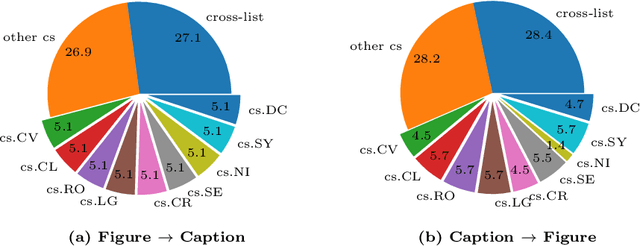
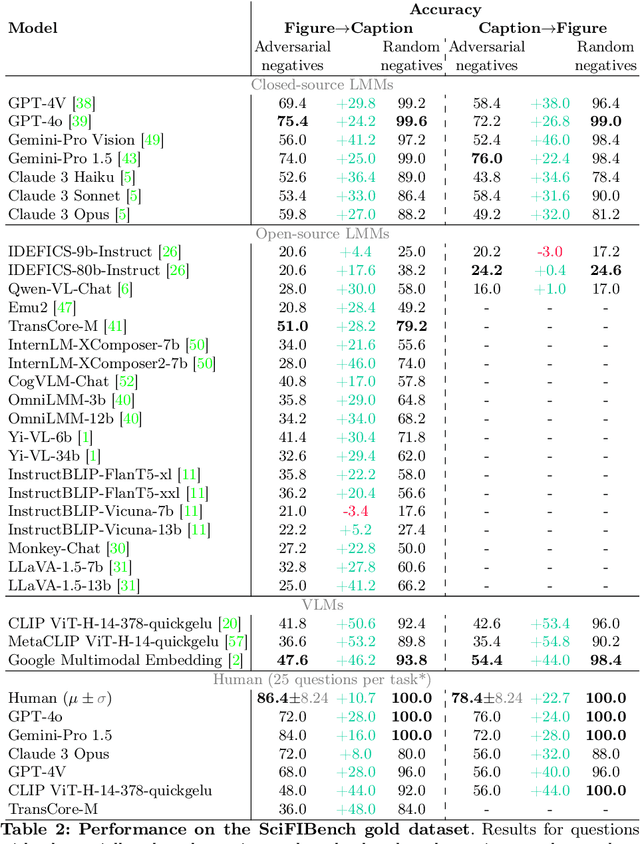
Abstract:Large multimodal models (LMMs) have proven flexible and generalisable across many tasks and fields. Although they have strong potential to aid scientific research, their capabilities in this domain are not well characterised. A key aspect of scientific research is the ability to understand and interpret figures, which serve as a rich, compressed source of complex information. In this work, we present SciFIBench, a scientific figure interpretation benchmark. Our main benchmark consists of a 1000-question gold set of multiple-choice questions split between two tasks across 12 categories. The questions are curated from CS arXiv paper figures and captions, using adversarial filtering to find hard negatives and human verification for quality control. We evaluate 26 LMMs on SciFIBench, finding it to be a challenging benchmark. Finally, we investigate the alignment and reasoning faithfulness of the LMMs on augmented question sets from our benchmark. We release SciFIBench to encourage progress in this domain.
Capabilities of Gemini Models in Medicine
May 01, 2024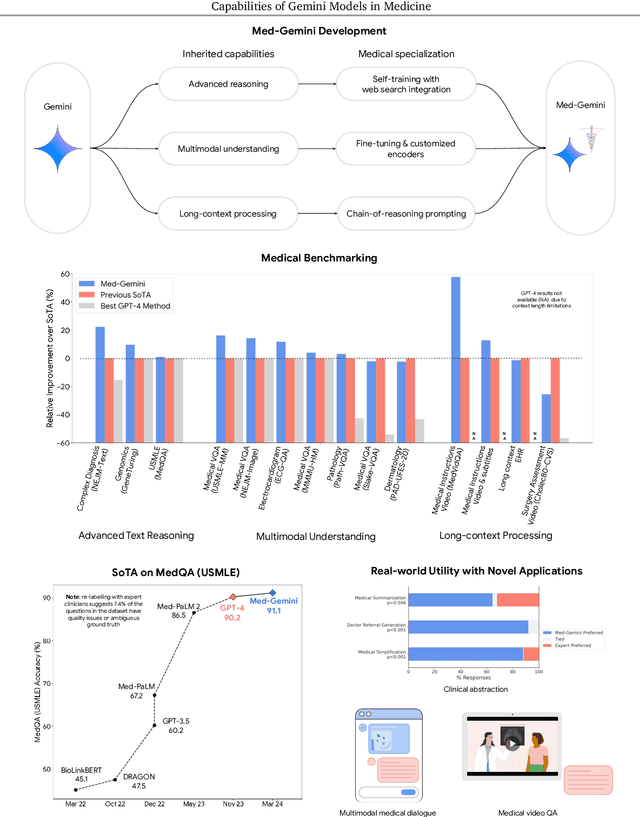

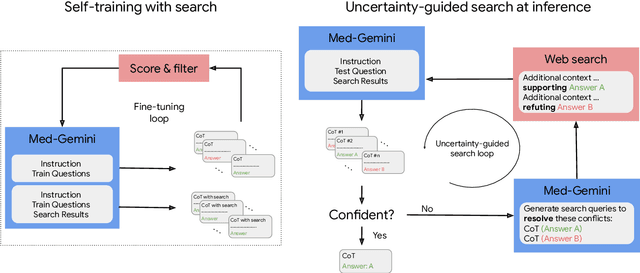

Abstract:Excellence in a wide variety of medical applications poses considerable challenges for AI, requiring advanced reasoning, access to up-to-date medical knowledge and understanding of complex multimodal data. Gemini models, with strong general capabilities in multimodal and long-context reasoning, offer exciting possibilities in medicine. Building on these core strengths of Gemini, we introduce Med-Gemini, a family of highly capable multimodal models that are specialized in medicine with the ability to seamlessly use web search, and that can be efficiently tailored to novel modalities using custom encoders. We evaluate Med-Gemini on 14 medical benchmarks, establishing new state-of-the-art (SoTA) performance on 10 of them, and surpass the GPT-4 model family on every benchmark where a direct comparison is viable, often by a wide margin. On the popular MedQA (USMLE) benchmark, our best-performing Med-Gemini model achieves SoTA performance of 91.1% accuracy, using a novel uncertainty-guided search strategy. On 7 multimodal benchmarks including NEJM Image Challenges and MMMU (health & medicine), Med-Gemini improves over GPT-4V by an average relative margin of 44.5%. We demonstrate the effectiveness of Med-Gemini's long-context capabilities through SoTA performance on a needle-in-a-haystack retrieval task from long de-identified health records and medical video question answering, surpassing prior bespoke methods using only in-context learning. Finally, Med-Gemini's performance suggests real-world utility by surpassing human experts on tasks such as medical text summarization, alongside demonstrations of promising potential for multimodal medical dialogue, medical research and education. Taken together, our results offer compelling evidence for Med-Gemini's potential, although further rigorous evaluation will be crucial before real-world deployment in this safety-critical domain.
Frozen Feature Augmentation for Few-Shot Image Classification
Mar 15, 2024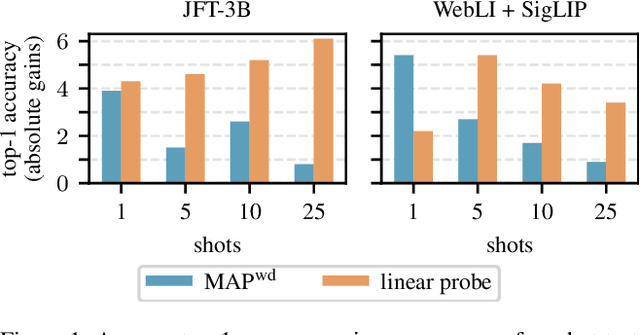

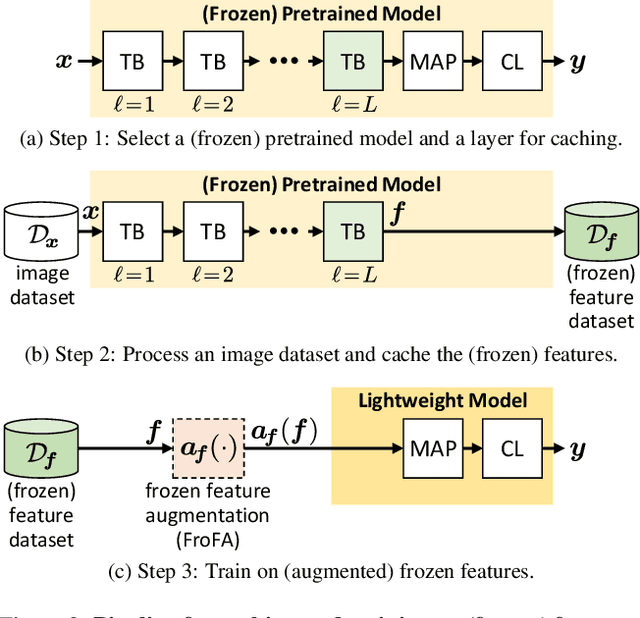

Abstract:Training a linear classifier or lightweight model on top of pretrained vision model outputs, so-called 'frozen features', leads to impressive performance on a number of downstream few-shot tasks. Currently, frozen features are not modified during training. On the other hand, when networks are trained directly on images, data augmentation is a standard recipe that improves performance with no substantial overhead. In this paper, we conduct an extensive pilot study on few-shot image classification that explores applying data augmentations in the frozen feature space, dubbed 'frozen feature augmentation (FroFA)', covering twenty augmentations in total. Our study demonstrates that adopting a deceptively simple pointwise FroFA, such as brightness, can improve few-shot performance consistently across three network architectures, three large pretraining datasets, and eight transfer datasets.
Gemini 1.5: Unlocking multimodal understanding across millions of tokens of context
Mar 08, 2024Abstract:In this report, we present the latest model of the Gemini family, Gemini 1.5 Pro, a highly compute-efficient multimodal mixture-of-experts model capable of recalling and reasoning over fine-grained information from millions of tokens of context, including multiple long documents and hours of video and audio. Gemini 1.5 Pro achieves near-perfect recall on long-context retrieval tasks across modalities, improves the state-of-the-art in long-document QA, long-video QA and long-context ASR, and matches or surpasses Gemini 1.0 Ultra's state-of-the-art performance across a broad set of benchmarks. Studying the limits of Gemini 1.5 Pro's long-context ability, we find continued improvement in next-token prediction and near-perfect retrieval (>99%) up to at least 10M tokens, a generational leap over existing models such as Claude 2.1 (200k) and GPT-4 Turbo (128k). Finally, we highlight surprising new capabilities of large language models at the frontier; when given a grammar manual for Kalamang, a language with fewer than 200 speakers worldwide, the model learns to translate English to Kalamang at a similar level to a person who learned from the same content.
Gemini: A Family of Highly Capable Multimodal Models
Dec 19, 2023Abstract:This report introduces a new family of multimodal models, Gemini, that exhibit remarkable capabilities across image, audio, video, and text understanding. The Gemini family consists of Ultra, Pro, and Nano sizes, suitable for applications ranging from complex reasoning tasks to on-device memory-constrained use-cases. Evaluation on a broad range of benchmarks shows that our most-capable Gemini Ultra model advances the state of the art in 30 of 32 of these benchmarks - notably being the first model to achieve human-expert performance on the well-studied exam benchmark MMLU, and improving the state of the art in every one of the 20 multimodal benchmarks we examined. We believe that the new capabilities of Gemini models in cross-modal reasoning and language understanding will enable a wide variety of use cases and we discuss our approach toward deploying them responsibly to users.
Scaling Laws for Sparsely-Connected Foundation Models
Sep 15, 2023Abstract:We explore the impact of parameter sparsity on the scaling behavior of Transformers trained on massive datasets (i.e., "foundation models"), in both vision and language domains. In this setting, we identify the first scaling law describing the relationship between weight sparsity, number of non-zero parameters, and amount of training data, which we validate empirically across model and data scales; on ViT/JFT-4B and T5/C4. These results allow us to characterize the "optimal sparsity", the sparsity level which yields the best performance for a given effective model size and training budget. For a fixed number of non-zero parameters, we identify that the optimal sparsity increases with the amount of data used for training. We also extend our study to different sparsity structures (such as the hardware-friendly n:m pattern) and strategies (such as starting from a pretrained dense model). Our findings shed light on the power and limitations of weight sparsity across various parameter and computational settings, offering both theoretical understanding and practical implications for leveraging sparsity towards computational efficiency improvements.
From Sparse to Soft Mixtures of Experts
Aug 02, 2023Abstract:Sparse mixture of expert architectures (MoEs) scale model capacity without large increases in training or inference costs. Despite their success, MoEs suffer from a number of issues: training instability, token dropping, inability to scale the number of experts, or ineffective finetuning. In this work, we proposeSoft MoE, a fully-differentiable sparse Transformer that addresses these challenges, while maintaining the benefits of MoEs. Soft MoE performs an implicit soft assignment by passing different weighted combinations of all input tokens to each expert. As in other MoE works, experts in Soft MoE only process a subset of the (combined) tokens, enabling larger model capacity at lower inference cost. In the context of visual recognition, Soft MoE greatly outperforms standard Transformers (ViTs) and popular MoE variants (Tokens Choice and Experts Choice). For example, Soft MoE-Base/16 requires 10.5x lower inference cost (5.7x lower wall-clock time) than ViT-Huge/14 while matching its performance after similar training. Soft MoE also scales well: Soft MoE Huge/14 with 128 experts in 16 MoE layers has over 40x more parameters than ViT Huge/14, while inference time cost grows by only 2%, and it performs substantially better.
 Add to Chrome
Add to Chrome Add to Firefox
Add to Firefox Add to Edge
Add to Edge